Supplemental Digital Content is available in the text
Keywords: China, discrete choice experiment, inequality, job preference, medical students, mixed logit model
Abstract
Although the number of medical workers has increased rapidly, its scarcity in rural areas remains a serious problem in China. This study aimed to investigate medical students’ stated preferences when choosing a job, so as to assist policy makers with designing alternative interventions to address the unbalanced distribution of the health workforce in China.
A discrete choice experiment (DCE) was conducted to elicit the job preferences of final year medical students. Attributes include work location, hospital type, monthly income, bianzhi (which can be loosely regarded as state administrative staffing), work environment, Training and career development opportunity. This study was carried out during April to June 2017 in 4 medical universities in Shandong Province, China. Mixed logit models were used to analyze the relative importance of job attributes.
A total of 519 medical students participated in the survey. All 6 attributes were statistically significant with the expected sign and demonstrated the existence of preference heterogeneity. In the main effects mixed logit model, working in the city and a superior working environment were most strongly associated with job preference. A relatively unexpected finding was the relatively lower utility of offering bianzhi in job preferences. Subgroup analysis showed that females and those who have an urban background were significantly willing to pay more for working in the city. The most preferred scenario for medical students was to select a better work environment job in a tertiary hospital in the city, which could offer 9000 CNY monthly, with sufficient training and career development opportunities and bianzhi.
Both monetary and nonmonetary intervention could be considered by policy makers to attract medical students to work in rural areas in China. There exists preference heterogeneity on medical students’ job preferences, which should also be taken into account in developing more effective policy incentive packages.
1. Introduction
Unbalanced distribution of the health workforce between and within countries is a longstanding issue worldwide, contributing to disparities in health outcomes between the rural and urban population.[1] Delivering healthcare services to underserved populations is a critical aspect in achieving the Millennium Development Goals.[2] To achieve equity in health is an important aspect of social fairness, whereas one of the biggest challenges is achieving equity in health workforce distribution.[1,3–6] Although the World Health Organization has recommended several policy interventions, such as recruiting students with a rural background and embedding a rural course so that students would become more familiar with remote conditions and more likely to return to rural areas after graduation,[4] the distribution of the health workforce remains a big problem to address in both developed and developing countries.
Unequal distribution of health workforce in rural and remote areas is one of the main causes for the “Kan Bing Nan” (seeking health care is difficult) in mainland China,[7] it has long been a concern of China's government, even in more developed regions.[8,9] Since 1989, hospitals in China are classified into a three-tier system according to their size and function.[10] Primary hospitals or health institutions offer preventive, clinical treatment, health care and rehabilitation service in a community.[10] Secondary hospitals are those located at county and district levels which mainly provide general health services to local residents but also undertake some clinical practice teaching and medical research.[10] Tertiary hospitals are the highest level of hospital in China and include national, provincial, municipal and medical-school-affiliated hospitals (which provide a wide range of health services including specialist services).[10] By the end of 2016, there were 29,140 hospitals nationwide, including 2232 (7.7%) tertiary hospitals, 7944 (27.3%) secondary hospitals, 9282 (31.9%) primary hospitals, and 9682 (33.2%) unclassified hospitals; in addition, there were 926,518 primary health care facilities.[11] In 2016, visits for physicians per day in tertiary hospitals, secondary hospitals, and primary hospitals were 8.1, 6.9, and 6.1 respectively. Hospital bed utilization was 98.8% in tertiary hospitals, 84.2% in secondary hospitals, but 58.0% in primary hospitals.[11]
Along with the economic growth in China, the number of urban health workers grew dramatically, with an increase of 129.94% from 2000 to 2011, while an increase of only 7.51% was observed in rural areas during the same period.[12] Even several strategies (e.g., providing financial supports to improve rural retention[13]) have been implemented by the Chinese government to attract and retain health workers in rural and remote areas,[14] by 2016, the number of medical practitioners and assistant medical practitioners per thousand population was 3.92 in the urban area, as compared to 1.59 in the rural China,[15] the urban–rural gap has been enlarged.[16]
Considering that a range of factors could influence health professionals’ motivation on job choices, an appropriately selected combination of incentives would be needed to effectively attract and retain medical students to rural areas.[17]
This study aims to shed light on this important policy issue in China through conducting discrete choice experiments (DCEs) with final year medical students who will soon be on the job market. DCE has become an increasingly popular tool for understanding people's preferences in healthcare settings, including job choice for health professionals.[18–20] The results of this study will facilitate the development of more effective policies for the attraction and retention of medical students to rural areas of China.
2. Materials and methods
2.1. Setting
This study was conducted in Shandong Province, which is located in eastern China with a population of more than 100 million.[15] In 2016, the gross regional product of Shandong Province amounted to CNY6803 billion (US$1024 billion), ranking it as the third largest economy within China.[15] Furthermore, there are 8 medical universities located in Shandong Province, ranked the second among 31 provinces.[21]
2.2. Discrete choice experiment design
DCE is a technique that aims to elicit stated preferences of individuals.[22] It has become a commonly used instrument in health economics.[23] Random utility theory provides the theoretical foundation for DCEs, it assumes that the respondents will choose the option that provides them with the highest utility among the alternatives been presented.[22,24]
The first step to design DCEs is to identify the attributes and corresponding levels. Initially 6 attributes which have been commonly adopted and suitable for the Chinese health care system were identified through a literature review,[5,17,25–30] including location, monthly income, bianzhi (which can be loosely regarded as state administrative staffing), training and career development opportunity, work environment and workload. An in-depth interview was then conducted with 12 medical students from 3 different medical universities (Jining Medical University, Taishan Medical University, and Weifang Medical University). It was suggested that the attribute of “workload” be removed. In addition, a focus group discussion was conducted among 10 final year medical students from Weifang Medical University. In the focus group, the participants were asked to discuss the remaining 5 attributes and their levels until they reached a consensus for the final version of attributes and levels. They were also asked to provide other attributes that they thought were important but were not in the list. As a result, the “hospital type” was further added as a new attribute. In sum, the final attributes and their levels (reported in Table 1) were decided on the basis of the literature review, in-depth interview, focus group discussion as well as discussions with a senior health economist who is an expert on DCEs.
Table 1.
DCE attributes and levels for final year medical students in China.
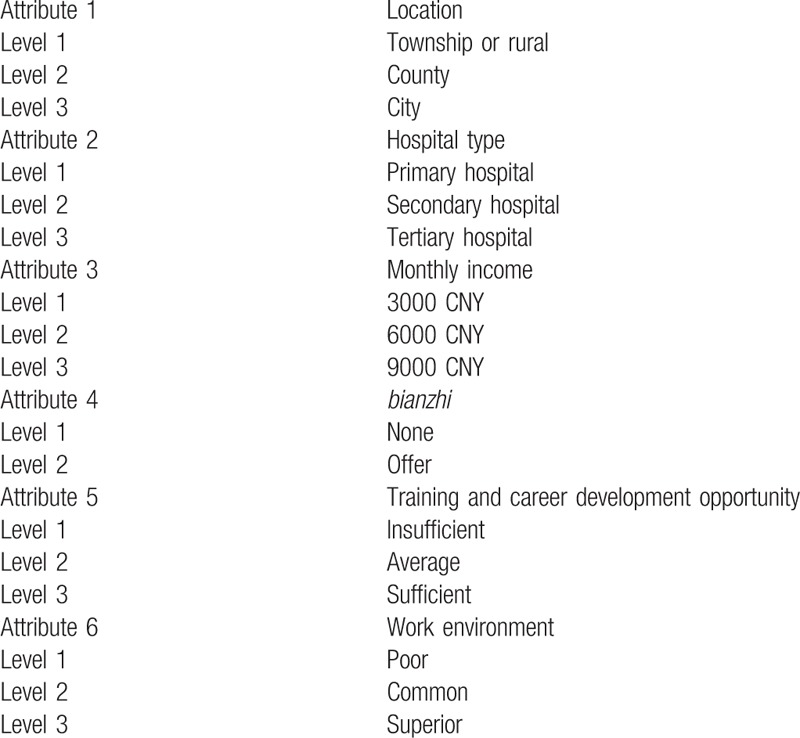
Out of 6 attributes, 5 attributes had 3 levels, and one attribute had 2 levels. An efficient design was used to generate a more manageable 24 scenarios (which were further blocked into 2 versions) using the Ngene software.[31] There is a duplicated choice set within each version to check the internal consistency. All participants were randomized to receive one of the 2 versions of the DCE questionnaire. An example of the DCE choice set is given in Table 2.
Table 2.
Example combination of choice: which of these jobs would you prefer?.

2.3. Survey and data collection
In addition to the DCE questions, the hard-copy questionnaire also contains questions related to participants’ sociodemographic characteristics, career planning, and family income. There is also a ranking exercise prior to the DCE tasks that was used to further examine the internal predictive validity of the DCE estimates, in which participants were asked to rank the attributes from most important to least important with respect to their preferences for choosing a job (Fig. 1).
Figure 1.
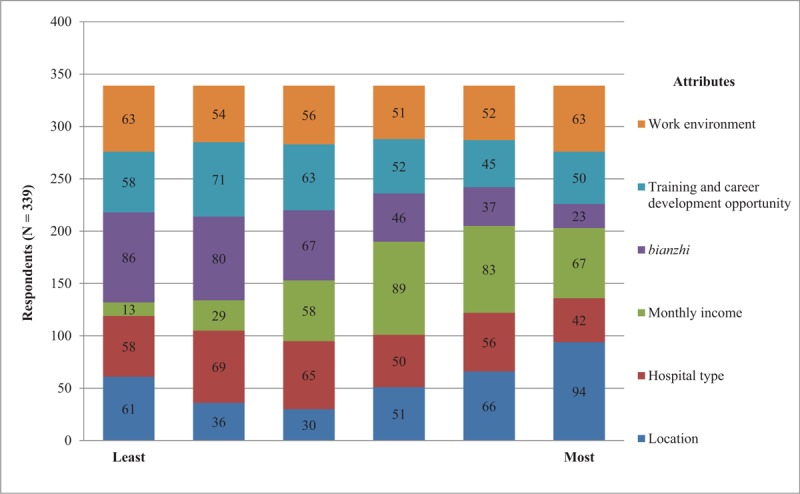
Ranking job posting attributes according to their importance.
The full questionnaire was piloted among medical students at Weifang Medical University before data were collected from the final year medical students between April and June, 2017. The timing of the survey was chosen at that time period because students had finished clinical training and were considering job opportunities but had not yet made their placement decisions.[22] Around 5 out of 8 medical universities in Shandong province are provincial independent medical universities. Considering the different education system and potentially different career path of graduates from the Shandong University of Traditional Chinese Medicine (as compared to the other 4 independent medical universities), it was excluded. The participants of this study were recruited from Jining Medical University, Taishan Medical University, Weifang Medical University, and Binzhou Medical University, which are located in Jining, Taian, Weifang, and Yantai city of Shandong Province, respectively.
A cluster random sampling method was used and we aimed to recruit a minimum of 100 respondents from each medical university.[32] Consequently, 2 or 3 classes in each medical university were randomly selected depending on the number of medical students in each class. The survey was conducted in a classroom setting. The meaning of the survey as well as the instructions on the DCEs was explained in detailed by one researcher. Then students filled in the questionnaire by themselves and all responses were anonymous.
2.4. Data analysis
Data were double-entered into Epidata 3.1 (Epidata Association, Odense, Denmark) and transferred to Stata 12.0 (Stata Corp LLC, College Station, TX) for processing and analysis. Descriptive statistics were reported for participants’ sociodemographic characteristics as well as the ranking exercise data. Random utility theory provides the theoretical foundation for analysis of the DCEs data. The utility (U) associated with a particular job is made up of 2 components: the deterministic component Vni (where V is a function of observable characteristics) and the unobservable component εni.[33] The utility, U, to individual n associated with job i can be specified as
 |
Where the estimated coefficient, β1 toβ10, provide quantitative information on the strength of preference for each attribute level. The DCE data were analyzed using the mixed logit model which can take into account the potential preference heterogeneity of participants.[29,34] All attributes were dummy coded, except for monthly income which was specified as a continuous variable in the models to facilitate the calculation of willingness to pay (WTP), that is, the relative monetary value that medical students place on various aspect of the job options.[35] Through calculating the ratios of the coefficients between each attribute level and the salary attribute, the marginal rate of substitution or WTP was calculated.[25] Finally, we also conducted a simulation study to understand to what extent the probability of choosing a given post changes as the levels of the attributes are changed.[33]
3. Results
Among a total of 558 final-year medical students who were invited to participate the study, 519 (93.0%) consented and finished the survey. The number of participates from 4 medical universities were 123 (Jining), 148 (Taishan), 131 (Weifang), and 117 (Binzhou), respectively. Among them, 30 participants (Jining: 4, Taishan: 15, Weifang: 6, and Binzhou: 5) who did not complete the majority of DCE tasks were excluded from the analysis. For internal consistency, a choice test based on duplicated choice tasks among the remaining 489 participants resulted in 150 participants failing the test. The detailed results reported below were based on 339 participants who passed the internal consistency tests. Meanwhile, a sensitivity analysis including all 489 participants was conducted and the results are comparable to the results reported below (see Table, Supplemental Content, which demonstrates the main effects model results of the full sample group).
3.1. Participants’ characteristics
The sociodemographic characteristics are shown in Table 3. There were no significant differences between those who passed or failed the internal consistency tests. The analysis sample (n=339) had a mean age of 23.4 years (SD = 1.0). Most (62%) of them were female and 55%of them came from rural areas and were not the single-child within their families. Around 32% of final-year participants prefer the job market and 64% prefer to further their study after graduation.
Table 3.
Demographic characteristics of final year medical students.
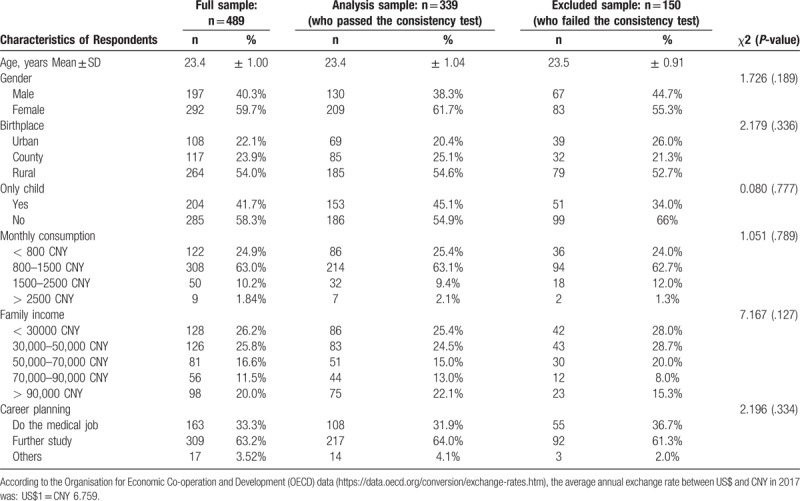
3.2. Main effects model results
The main effects regression results are reported in Table 4. The signs on all the attributes were as expected and were all statistically significant. The most important attribute for medical students was working in the city (β=1.728, P < .001), followed by superior working environment (β=1.514, P < .001). Although bianzhi had a positive effect for the respondents (β=0.188, p=.004), it did not appear to be as important as the other attributes. In addition, the results of rank ordering (Fig. 1) indicate that work location, monthly income and work environment were regarded as the most important job attributes. This is consistent with the results of the main effects mixed logit mode and supports the internal predictive validity of the model.
Table 4.
Main effects model results and WTP (n = 339).
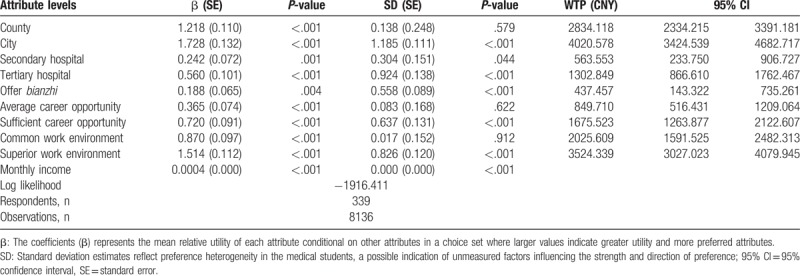
The results of the WTP calculation are also shown in Table 4 and are used for relative comparisons. The WTP for work location and work environment gives us a clear indication about the importance of these 2 attributes. On average, the medical students were willing to pay 4,020 CNY and 3,524 CNY per month to work in the city and getting a superior work environment, as compared to the work in a township hospital in rural areas and work in a poor environment, respectively. In terms of offering bianzhi or not, medical students were willing to pay only 437 CNY to get it. The results of selective subgroup analyses are presented in Tables 5 and 6. As can be seen, females and those who have an urban background were significantly willing to pay more for working in the city. If respondents mainly opt to further studying instead of getting a job, the bianzhi become insignificant.
Table 5.
Subgroups effects model results.
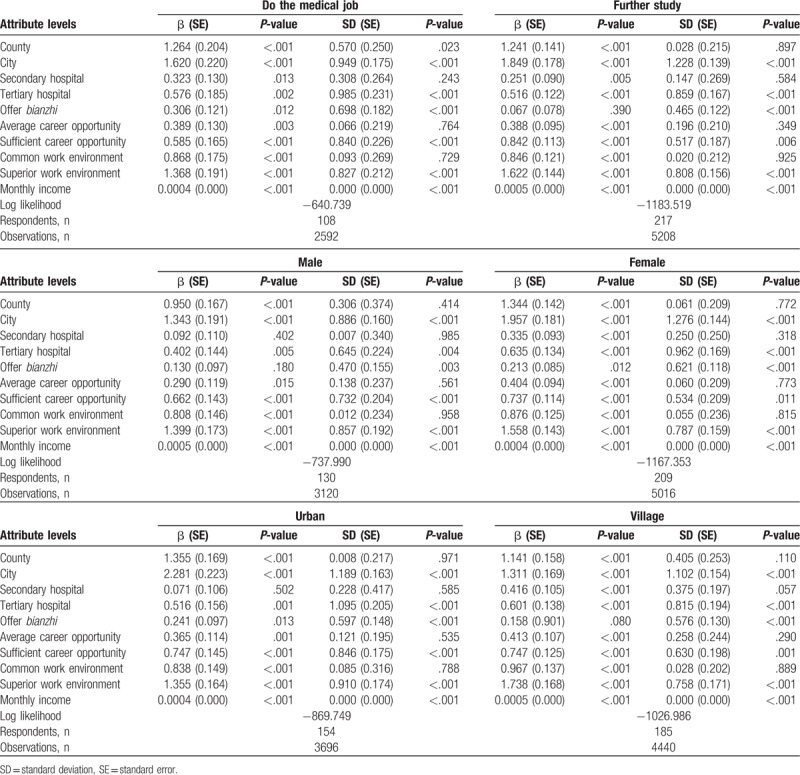
Table 6.
WTP (CNY) for subgroups; 95% CI.

3.3. Simulated preferences for job posting under various rural potential policy scenarios
The simulation results are shown in Figure 2. For the single incentives, increasing the monthly income from 3000 to 9000 CNY had the largest effect on preference for rural postings, and improving the work environment from poor to superior increased the probability by 63.9% and improved the rank to second. In comparison, offering bianzhi and working in a tertiary hospital increased the respective probability of taking a rural job by only 9.4% and 27.3%. For the multiple incentives, the job posting “② + ⑦ + ⑨” was the most attractive one, as it increased the probability by 98.4%.
Figure 2.
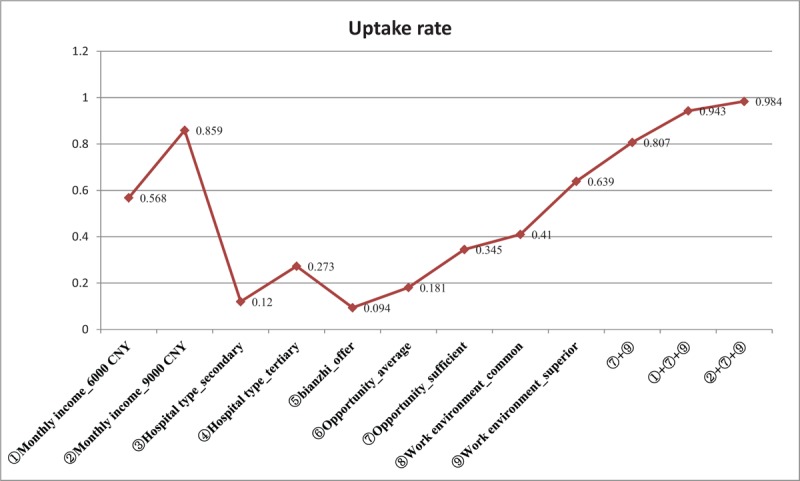
Simulated preferences for rural job posting under various potential policy scenarios. Baseline job posting: Monthly income_ 3000 CNY, Work location_ rural, Hospital type_ primary, bianzhi_none, Training and career development opportunity_ insufficient, Work environment_ poor. This seems a worst-case scenario, but the reality is that it is rather close to many rural areas in China.
4. Discussion
To the best of our knowledge, this is the first study to investigate job preferences of medical students using DCEs in China. Consistent with previous studies in other countries, the results in China highlighted that both monetary and nonmonetary factors (such as work location and work environment) significantly influence job preference for a health worker.[36,37] The mixed logit estimates further suggest the existence of preference heterogeneity in all 6 attributes.
Among nonmonetary factors, work location is one of the most important factors, especially for female students. Living conditions in most of the rural areas are still poor compared with urban areas in terms of infrastructure (e.g., telecommunications and transportation) and education opportunity for the children, this could be one of the main barriers for health manpower distribution to rural areas.[38] Studies from other countries have reported that the more centrally located the job, the more it will be preferred by health workers.[39,40] The relationship between geographical origin of students and their future choice of work, that is, whether medical students from rural areas will more likely to return to rural areas to practice, has been reviewed and discussed in Lehmann et al.[38] Our study reveals that compared to students from rural areas, those from urban areas shown a much stronger preference to work in city rather than in county, or rural areas. Therefore, attracting and retaining students with a rural background for rural areas would be a more feasible strategy. Experience from countries as diverse as Australia, Indonesia, and Thailand, has also shown that health workers with a rural background are more likely to practice in rural areas after completing their studies.[41]
Work environment is another important nonmonetary factor. It refers to management support, the relationship between superior and subordinate, high-risk work environments, and availability of equipment; it has been identified by other studies as a key factor in deciding whether to leave or stay in remote areas.[42,43] Medical students in our study confirm this finding. They were willing to pay about 3524 CNY per month in order to have a superior work environment, which ranking second among the 5 nonmonetary attributes.
The career and further training opportunity and hospital levels are found to have slightly smaller effect than the work location and work environment attributes. It seems contrary to other studies conducted in Kenya[27] or Mozambique,[44] in which opportunities for career development and further education were found to be much stronger predictors of choice. It could be that the respondents in our study were still final year medical students just finishing their clinical placement and further training opportunities may not be regarded as important at the very beginning of their career. On the other hand, the in-depth interview with twelve medical students conducted before the DCE provides us with some insights on the importance of hospital level. During the interviews, 9 medical students indicated they were worried about whether they can adapt to more intense competition and the difficult clinical cases of tertiary hospital work. Another study on nurses also indicated the similar point.[25]
An unexpected finding from our study is the relatively lower utility of bianzhi in job preferences. It was contrary to another study which was strongly suggestive of a preference for providing bianzhi in China.[26] There could be 2 explanations. Firstly, all participants in our study were born after 1990. For this younger generation a job with bianzhi may be more stable but may not be as important as it may be for older generations. Secondly, the recent health reform has witness an important role of the private health sector in the Chinese health system. Medical students have more opportunity to work in private hospitals which normally provide better salaries and working environments. Consequently, the bianzhi in public hospitals may not be as important as it used to be. The DCE results were consistent with the ranking exercise findings presented in Figure 1, in that only 23 (6.7%) respondents ranked bianzhi as the most important attribute in job choice.
Policy simulations show to what extent a change on a particular attribute level and/or a combination of attributes can impact on the job choice. With regard to monthly income, increasing it from 3000 CNY to 9000 CNY had the highest impact on a rural job choice. In comparison, medical students do not value opportunities for training and career development so highly. According to Maslow's Hierarchy of Needs and the study achieved by McAuliffe, [28] once remuneration rates reach a level that allows health workers to meet their basic needs, other considerations may become more important than pay. Therefore, unsatisfied remuneration among medical workers in China [45,46] could be the underlying reason that caused the above phenomenon. One study on primary care providers’ job satisfaction in China also found that income and benefits were the least satisfied items.[45] Thus, when making a policy for attracting medical students to rural areas, it is necessary for policy makers to consider their basic needs as a priority.
Although the simulation indicates that increasing monthly income from 3000 to 9000 CNY had the largest effect on preference for rural postings, it is often not possible in the real world, for example it may require significant financial investments upfront, such that policy makers may be deterred from implementing this intervention.[4] Alternatively, a combination of nonmonetary incentives (such as better work environment, sufficient training and career development opportunities) can achieve similar impact as monetary incentive. This simulation highlighted that in the rural areas, in which the financial resources for health resources are limited; policy intervention could pay more attention to those nonmonetary attributes, in order to attract medical students.
This study has 2 limitations. Firstly, similar to other DCEs in which we have studied only the stated preferences, it would be ideal to also investigate the revealed preferences based on actual behavior.[28] Secondly, only medical universities from Shandong Province were included in this research whereas normally students came from different region of China.
5. Conclusions
In conclusion, for medical students in China, the preferred scenario was to select a better work environment job in a tertiary hospital located in the city, which can offer 9000 CNY monthly, sufficient training and career development opportunities and with bianzhi. Both monetary and nonmonetary intervention could be considered by policy makers to attract medical students to work in rural areas. There exists preference heterogeneity on medical students’ job preferences, which should also be taken into account in developing more effective policy incentive packages.
Acknowledgments
The authors thank all the participants for their time and effort. Responsibility for any remaining errors lies solely with the authors.
Author contributions
Shimeng Liu designed the study, completed the data collection and analyses, and wrote the manuscript. Shunping Li designed the study, collected the data, and edited the manuscript. Tongtong Liu designed the study and collected the data. Renyong Yang collected the data and edited the manuscript. Gang Chen designed the study, analyzed the data, and edited the manuscript. All authors have read and approved the final manuscript.
Conceptualization: Shunping Li.
Data curation: Shimeng Liu, Tongtong Liu, Gang Chen.
Funding acquisition: Shunping Li.
Investigation: Shimeng Liu, Renyong Yang, Tongtong Liu.
Methodology: Shimeng Liu.
Project administration: Shunping Li.
Resources: Renyong Yang.
Software: Gang Chen.
Writing – original draft: Shimeng Liu.
Writing – review & editing: Shunping Li, Renyong Yang, Tongtong Liu, Gang Chen.
Shunping Li: 0000-0001-8144-6220.
Supplementary Material
Footnotes
Abbreviations: β = mean utility coefficients, CI = confidence interval, CNY = China Yuan, DCE = discrete choice experiment, SD = standard deviation, SE = standard error, U = utility, WTP = willingness to pay.
Competing interests: The authors declare that they have no competing interests.
Funding: All meetings, time invested, travel, etc., were funded by the individuals. Ethics approval and consent to participate: Ethical approval (Reference No.20170301) was obtained from the Ethics Review Board of the School of Preventive Medicine, Shandong University, and the research adhered to the tenets of the Declaration of Helsinki.
The authors have no funding and no conflicts of interest to disclose.
Supplemental Digital Content is available for this article.
References
- [1].Dussault G, Franceschini MC. Not enough there, too many here: understanding geographical imbalances in the distribution of the health workforce. Hum Res Health 2006;4:1–6. [DOI] [PMC free article] [PubMed] [Google Scholar]
- [2].Grobler L, Marais BJ, Mabunda SA, et al. Interventions for increasing the proportion of health professionals practising in rural and other underserved areas. Cochrane Database Syst Rev 2009;1:CD005. [DOI] [PubMed] [Google Scholar]
- [3].World Health Organization. Working together for health: the world health report 2006. Popul Dev Rev Dec 2006;32:790–1. [Google Scholar]
- [4].WHO Guidelines Approved by the Guidelines Review Committee. Increasing Access to Health Workers in Remote and Rural Areas Through Improved Retention: Global Policy Recommendations. Geneva: World Health Organization; 2010. [PubMed] [Google Scholar]
- [5].Efendi F, Chen CM, Nursalam N, et al. How to attract health students to remote areas in Indonesia: a discrete choice experiment. Int J Health Plann Manage 2016;31:430–45. [DOI] [PubMed] [Google Scholar]
- [6].Culyer AJ, Wagstaff A. Equity and equality in health and health care. J Health Econ 1993;12:431–57. [DOI] [PubMed] [Google Scholar]
- [7].Li D, Zhou Z, Si Y, et al. Unequal distribution of health human resource in mainland China: what are the determinants from a comprehensive perspective? Int J Equity Health 2018;17:29. [DOI] [PMC free article] [PubMed] [Google Scholar]
- [8].Hu WP, Shen TB. Research on the current status and equity of health human resource allocation in Zhejiang province. Chin Hosp Manag 2015;35:42–4. (in Chinese). [Google Scholar]
- [9].Fu WQ, Liu GX, Wu QH. Analysis on the variation trends of medical personnel allocation in china grass-root medical organization under the background of medical reform. Chin Health Econ 2015;34:35–7. (in Chinese). [Google Scholar]
- [10].Meng QY, Yang HW, Chen W, et al. People's Republic of China: health system review. Health Syst Trans 2015;5:1–217. [Google Scholar]
- [11].National Health Commission of People's Republic of China. 2017. Available at: http://www.nhfpc.gov.cn/guihuaxxs/s10748/201708/d82fa7141696407abb4ef764f3edf095.shtml. Accessed July 18, 2018. [Google Scholar]
- [12].Zhou K, Zhang X, Ding Y, et al. Inequality trends of health workforce in different stages of medical system reform (1985-2011) in China. Hum Res Health 2015;13:94. [DOI] [PMC free article] [PubMed] [Google Scholar]
- [13].Current major project on health care system reform (2009–2011). Available at: http://www.gov.cn/zwgk/2009-04/07/content_1279256.htm. Accessed March 9, 2018. [Google Scholar]
- [14].Liu XY. International experiences and implications of attraction and retention of health workers in rural areas. Chin J Health Policy 2012;5:33–8. (in Chinese). [Google Scholar]
- [15].China Statistical Yearbook National Bureau of Statistics of the People's Republic of China 2017. Available at: http://www.stats.gov.cn/tjsj/ndsj/2017/indexch.htm. Accessed March 9, 2018. [Google Scholar]
- [16].Yang Q, Dong H. Have health human resources become more equal between rural and urban areas after the new reform? Int J Health Policy Manag 2014;3:359–60. [DOI] [PMC free article] [PubMed] [Google Scholar]
- [17].Jaskiewicz W, Phathammavong O, Vangkonevilay P. Toward Development of a Rural Retention Strategy in Lao People‘s Democratic Republic: understanding health worker preference. Washington, DC: Capacity Plus; 2012. [Google Scholar]
- [18].Blaauw D, Erasmus E, Pagaiya N, et al. Policy interventions that attract nurses to rural areas: a multicountry discrete choice experiment. Bull World Health Organ 2010;88:350–6. [DOI] [PMC free article] [PubMed] [Google Scholar]
- [19].Huicho L, Miranda JJ, Diez-Canseco F, et al. Job preferences of nurses and midwives for taking up a rural job in Peru: a discrete choice experiment. PLoS One 2012;7:e50315. [DOI] [PMC free article] [PubMed] [Google Scholar]
- [20].Rockers PC, Jaskiewicz W, Kruk ME, et al. Differences in preferences for rural job postings between nursing students and practicing nurses: evidence from a discrete choice experiment in Lao People's Democratic Republic. Hum Res Health 2013;11:22. [DOI] [PMC free article] [PubMed] [Google Scholar]
- [21].Cai SY. Analysis on distribution of higher medical education resources in China. Medicine and Philosophy 2015;36(12A):68–71. (in Chinese). [Google Scholar]
- [22].Lancsar E, Louviere J. Conducting discrete choice experiments to inform healthcare decision making: a user's guide. Pharmacoeconomics 2008;26:661–77. [DOI] [PubMed] [Google Scholar]
- [23].de Bekker-Grob EW, Ryan M, Gerard K. Discrete choice experiments in health economics: a review of the literature. Health economics 2012;21:145–72. [DOI] [PubMed] [Google Scholar]
- [24].Kraut AI, Wolfson AD, Rothenberg A. Some effects of position on opinion survey items. J Appl Psychol 1975;60:774–6. [Google Scholar]
- [25].Park BH, Ko Y. Hospital preferences of nursing students in Korea: a discrete choice experiment approach. Hum Res Health 2016;14:58. [DOI] [PMC free article] [PubMed] [Google Scholar]
- [26].Yan D, Zhang H, Chang J, et al. Job preferences of doctors at township health center: a discrete choice experiment in three provinces of China. Chin J Health Policy 2014;7:44–8. (in Chinese). [Google Scholar]
- [27].Takemura T, Kielmann K, Blaauw D. Job preferences among clinical officers in public sector facilities in rural Kenya: a discrete choice experiment. Hum Res Health 2016;14:1. [DOI] [PMC free article] [PubMed] [Google Scholar]
- [28].McAuliffe E, Galligan M, Revill P, et al. Factors influencing job preferences of health workers providing obstetric care: results from discrete choice experiments in Malawi, Mozambique and Tanzania. Global Health 2016;12:86. [DOI] [PMC free article] [PubMed] [Google Scholar]
- [29].Kruk ME, Johnson JC, Gyakobo M, et al. Rural practice preferences among medical students in Ghana: a discrete choice experiment. Bull World Health Org 2010;88:333–41. [DOI] [PMC free article] [PubMed] [Google Scholar]
- [30].Cleland JA, Johnston P, Watson V, et al. What do UK medical students value most in their careers? A discrete choice experiment. Med Educ 2017;51:839–51. [DOI] [PubMed] [Google Scholar]
- [31].Choice Metrics. Ngene Software. Available at: http://www.choice-metrics.com. Accessed September 9, 2017. [Google Scholar]
- [32].de Bekker-Grob EW, Donkers B, Jonker MF, et al. Sample size requirements for discrete-choice experiments in healthcare: a practical guide. Patient 2015;8:373–84. [DOI] [PMC free article] [PubMed] [Google Scholar]
- [33].World Health Organization, CapacityPlus-USAID, Bank TW. How to Conduct a Discrete Choice Experiment for Health Workforce Recruitment and Retention in Remote and Rural Areas: A User Guide with Case Studies. Geneva: World Health Organization; 2012. [Google Scholar]
- [34].McFadden D, Train K. Mixed MNL models for discrete response. J Appl Econ 2000;15:447–70. [Google Scholar]
- [35].Vujicic M, Shengelia B, Alfano M, et al. Physician shortages in rural Vietnam: using a labor market approach to inform policy. Social Sci Med (1982) 2011;73:970–7. [DOI] [PubMed] [Google Scholar]
- [36].Chomitz KM, Setiadi G, Azwar A. Developing incentives for doctors to serve in Indonesia's rural and remote areas. Policy Res Working Paper 1998;37:270–2. [Google Scholar]
- [37].Scott A. Eliciting GPs’ preferences for pecuniary and non-pecuniary job characteristics. J Health Econ 2001;20:329–47. [DOI] [PubMed] [Google Scholar]
- [38].Lehmann U, Dieleman M, Martineau T. Staffing remote rural areas in middle- and low-income countries: a literature review of attraction and retention. BMC Health Serv Res 2008;8:19. [DOI] [PMC free article] [PubMed] [Google Scholar]
- [39].Smitz MF, Witter S, Lemiere C, et al. Understanding health workers’ job preferences to improve rural retention in timor-leste: findings from a discrete choice experiment. PLoS One 2016;11:e0165940. [DOI] [PMC free article] [PubMed] [Google Scholar]
- [40].Kolstad JR. How to make rural jobs more attractive to health workers. Findings from a discrete choice experiment in Tanzania. Health Econ 2011;20:196–211. [DOI] [PubMed] [Google Scholar]
- [41].Araújo E, Maeda A. How to recruit and retain health workers in rural and remote areas in developing countries: a guidance note. Health, nutrition and population (HNP) discussion paper. Washington, D.C: World Bank; 2013. (http://www.who.int/workforcealliance/knowledge/resources/wb_retentionguidancenote/en/). [Google Scholar]
- [42].Regional Office for Africa World Health Organisation, Awases M, Gbary A, Nyoni J, et al. Migration of Health Professionals in Six Countries: A Synthesis Report. 2004;65. [Google Scholar]
- [43].Zurn P, Dal Poz MR, Stilwell B, et al. Imbalance in the health workforce. Hum Res Health 2004;2:13. [DOI] [PMC free article] [PubMed] [Google Scholar]
- [44].Honda A, Vio F. Incentives for non-physician health professionals to work in the rural and remote areas of Mozambique—a discrete choice experiment for eliciting job preferences. Hum Res Health 2015;13:23. [DOI] [PMC free article] [PubMed] [Google Scholar]
- [45].Shi L, Song K, Rane S, et al. Factors associated with job satisfaction by Chinese primary care providers. Primary Health Care Res Dev 2014;15:46–57. [DOI] [PubMed] [Google Scholar]
- [46].Wen T, Zhang Y. Factors influencing turnover intention among primary care doctors: a cross-sectional study in Chongqing, China. Hum Res Health 2018;16:10. [DOI] [PMC free article] [PubMed] [Google Scholar]
Associated Data
This section collects any data citations, data availability statements, or supplementary materials included in this article.


